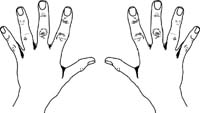Exploring Size Scaling
 Description: Students will explore size scaling
Description: Students will explore size scaling
Purpose: To show that objects remain the same size, despite changes in distance
Length of Activity: 5 - 10 minutes
Materials:
Steps:
1. Have students close one eye.
2. Then they should hold out their left hands in front of them at arm's length, palm out.
3. Tell students to lift their right hands in front of them, palm out, at about half the distance from their face.
4. Which hand looks bigger? Do they look about the same size?
5. Now have students keep one eye shut and their hands at the same distance from their face, but shift their closer hand slightly until it appears to them that their right hand is covering their left hand by a little bit. Which hand looks bigger now?
What’s Going On?
When the hands do not overlap, they look to be about the same size even though one is closer than the other. That's because the brain knows they are the same size. In fact, the images of your hands on your eye's retina are two different sizes, but your brain overrides this information with what it knows to be true. However, when the hands overlap, they look to be different sizes. That's because you brain now recognizes the overlap and realizes that means there is a difference in depth. The hand that's closer now appears larger, as it should.